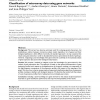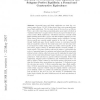1184 search results - page 232 / 237 » Nearness relations and topology |
BMCBI
2006
13 years 7 months ago
2006
Background: Molecular evolutionary studies of noncoding sequences rely on multiple alignments. Yet how multiple alignment accuracy varies across sequence types, tree topologies, d...
BMCBI
2007
13 years 7 months ago
2007
Background: The task of computing highly accurate structural alignments of proteins in very short computation time is still challenging. This is partly due to the complexity of pr...
BMCBI
2007
13 years 7 months ago
2007
Background: Microarrays have become extremely useful for analysing genetic phenomena, but establishing a relation between microarray analysis results (typically a list of genes) a...
COMGEO
2007
ACM
13 years 7 months ago
2007
ACM
In this paper we investigate the relations between spanners, weak spanners, and power spanners in RD for any dimension D and apply our results to topology control in wireless netw...
CORR
2007
Springer
13 years 7 months ago
2007
Springer
Abstract. Sequential game and Nash equilibrium are basic key concepts in game theory. In 1953, Kuhn showed that every sequential game has a Nash equilibrium. The two main steps of ...



